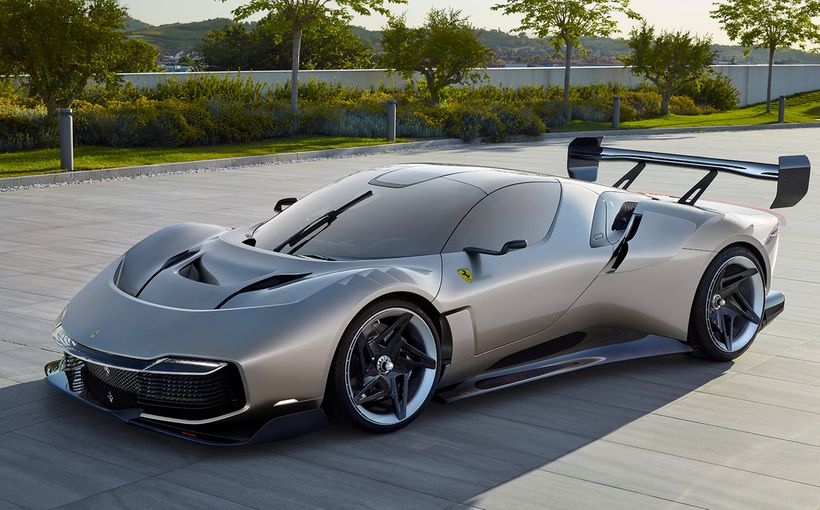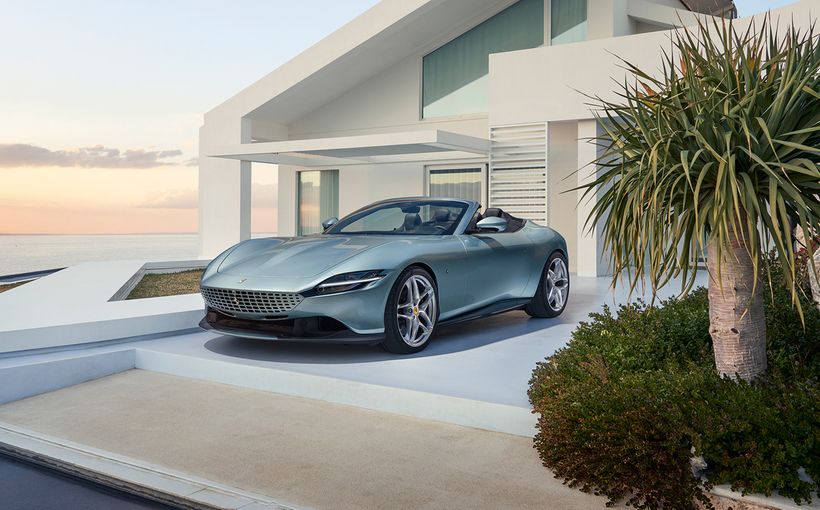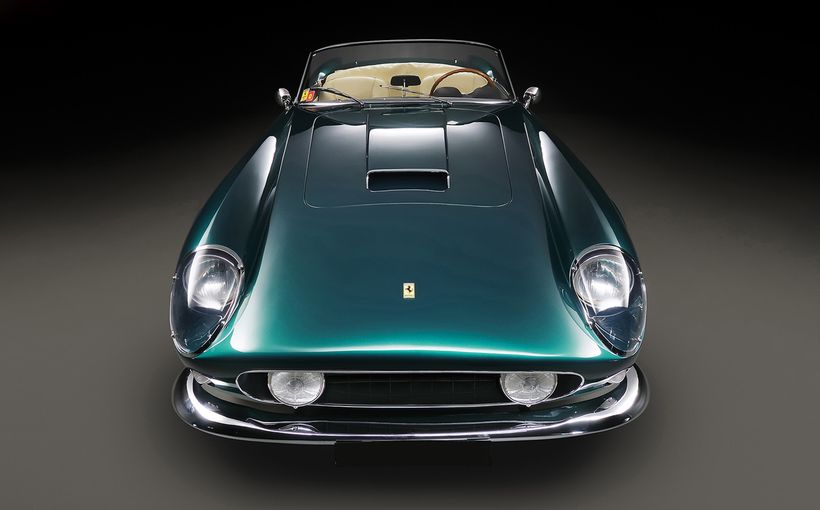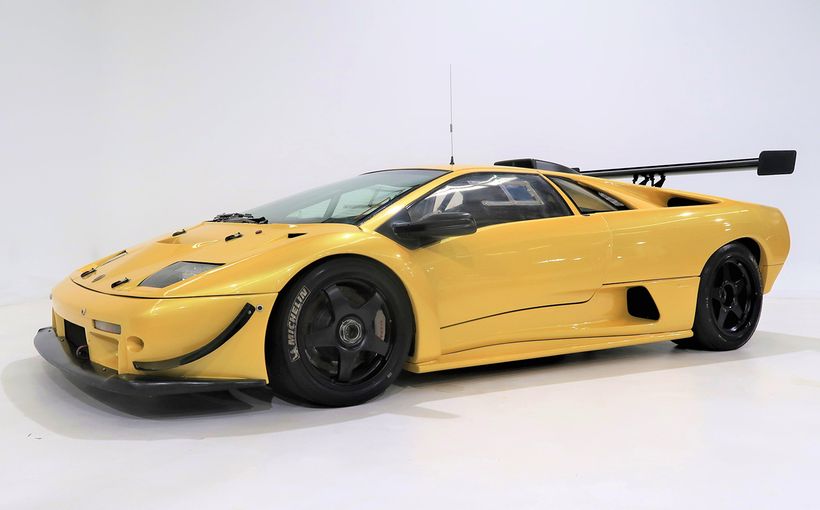Ferrari Dino: 'tiny, brilliant, safe…almost a Ferrari'

If there was ever a car that suffered from mindless badge snobbery, it was the Ferrari Dino. Although these smaller and lower-priced V6 and V8 models, named in posthumous honour of Enzo’s only son, brought design innovation and thousands of new customers to Maranello, Dino-badged cars were for many years wrongly perceived as not being worthy of wearing the coveted prancing horse badge.
In other words, they were not real Ferraris. Indeed, the sales brochure designed to entice buyers of the first Dino 206 GT described this new arrival as “tiny, brilliant, safe…almost a Ferrari.” With arms-length wording like that, it’s not hard to see why the so-called purists turned up their noses, even though the Dino name was already deeply embedded in Ferrari’s motor sport heritage and was a logical choice given its association with V6 racing engines.
As a result, for decades pre-owned Dinos could be purchased at relatively low prices and some used car dealers were known to affix Ferrari badges and insignia to the coachwork to entice reluctant buyers. Some image-conscious Dino owners also did this, which is ironic given the huge six-figure sums being paid for well-maintained early examples today - with the historically-correct Dino badging of prime importance!
Fact is, all Dinos were real Ferraris, built on the same Maranello production lines as their larger V12 siblings yet with unique innovation. The Dino sub-brand not only introduced non-V12s to Ferrari’s gran turismo line-up; the Dino was also the first mid-engined Ferrari road car and the first to have its engine mounted transversely.




Image: https://en.wheelsage.org/
It’s those mid-engine developments that make the Dino story so intriguing, given that by the mid-1960s F1 and sports car racing had evolved to the same format. Enzo Ferrari was initially reluctant to follow this evolutionary path with his V12 road cars, as he feared a mid-engined version would be unsafe in unskilled hands.
So, the concept of a smaller and less powerful sub-brand was inspired thinking, as it allowed mid-engined GTs to be pioneered in production with minimal risk to Ferrari’s reputation. However, it proved so successful that the first of many mid-engined 12-cylinder Ferraris soon followed, in the form of the iconic flat-12 Berlinetta Boxer in 1973.
The lower price point and unprecedented production numbers for Dino-badged Ferraris also substantially grew the company’s customer base which, let’s face it, was primarily to fund the Commendatore’s all-important racing activities.

Image: https://en.wheelsage.org/
Dino: ten years in the making
A decade before the launch of the first Dino 206 GT, Ferrari had started experimenting with the concept of a smaller and more affordable GT. Several concepts were trialled in the late 1950s and early 1960s, including the ‘Ferrarina’ and ‘Mille’ prototypes powered by in-line four-cylinder engines, which were never seriously considered for production at Maranello.
However, that all changed at the 1965 Paris Salon (motor show), with the unveiling of a mid-engine concept on the Pininfarina stand called the Dino 206 GT Speciale. This one-off show car was the first glimpse of what would evolve into a new generation of Ferraris, even though the prancing horse badge was conspicuous in its absence.
Its styling was characterised by an extremely low roof height, four headlights in the nose behind a single transparent cover and pronounced humps over the wheels. There was also a longitudinally mid-mounted 2.0 litre V6 equipped with four overhead camshafts; reportedly a direct descendance of the 1500cc unit which Phil Hill drove to victory in the 1961 F1 world championship.
‘Dino’ was the nickname of Enzo Ferrari’s only son, Alfredo, who tragically died from muscular dystrophy in 1956 when only 24 years of age. Like his father, racing was in Alfredo’s blood along with a passion for half-sized V12s it seemed, given that he had championed the design of a new 1500cc V6 (which planted the seed for Hill’s 1961 F1 engine) to power Ferrari’s new Formula 2 single-seater.
Although Alfredo died before he could see it compete, the 156 F2 was the first Maranello race car to bear the Dino badge in his honour. Ferrari V6 (and later V8 engines) thereafter carried the Dino name along with a new three-digit system of identification, with the first and second digits denoting displacement in litres and the third the number of cylinders, hence 206.
One year later, at the 1966 Turin Salon, the Pininfarina stand displayed what was clearly an evolution of the previous year’s show car. The new Dino Berlinetta GT still featured a longitudinally-mounted V6, but the coachwork was more compact and less streamlined, with an increase in roof height to accommodate taller drivers, more conventional fender-mounted single headlights with clear covers, a slender radiator air intake in the nose and other changes. The definitive shape of what would become the Dino 206 GT production car was rapidly evolving.

The 1966 Turin show also launched the sporty Fiat Dino with a stylish cabriolet body by Pininfarina. Of most significance in this context was its engine; a pre-production version of Ferrari’s Dino 206 GT unit with a compact 65-degree vee-angle, four overhead camshafts and a typically oversquare free-revving displacement of 1987cc.
This begs the question why Ferrari would share one of its prized competition-bred Dino engines with an automotive behemoth like Fiat? There was self-serving method in Enzo’s apparent madness, as Antoine Prunet explains in his wonderful book The Ferrari Legend, The Road Cars:
“As its name indicates, this V6 was conceived at Maranello with the idea of using it in a Formula 2 single seater but the rules of that formula stipulated that the engines had to be derived from mass-produced units. An agreement was entered into between Ferrari and the giant of Turin, Fiat, the terms of which allowed Fiat to build the engine in its factory and use it in a vehicle that could quickly attain a production of 500 examples as required for (race) homologation. And so, there came about a Fiat with a Ferrari engine.”
As a result, this engine was not only used in the Fiat Dino cabriolet and coupe. It also served as the basis of Ferrari’s F2 single-seater and destined for the new Dino 206 GT.

Image: https://en.wheelsage.org/
Dino 206 GT
The third and final Dino 206 GT prototype in three years was unveiled at the 1967 Turin Salon, which embodied most of the key engineering and styling features that would characterise the showroom version that soon followed.
The most significant change was the engine being mounted transversely, which although pioneered in Italian supercars the previous year by Lamborghini’s mesmerising V12 Miura - and arguably inspired by its innovation - was still considered cutting-edge at the time.
It also heralded three firsts for a Ferrari road car: V6, mid-engine and transverse-mounted. This triple innovation required the in-house design and manufacturer of an all-new five-speed full-synchromesh gearbox, tucked in close and parallel to the crankshaft. It was encased in a single aluminium alloy casting incorporating the sump, gearbox and differential, with separate lubrication systems for engine and transmission.
This compact drivetrain resulted in multiple benefits, including a reduced polar moment of inertia to maximise the handling benefits of its mid-engine, enough room behind it for a surprisingly spacious luggage compartment and a significant 60mm reduction in wheelbase to 2280mm.

The Fiat-built V6 was given special treatment by Ferrari, maintaining the same 9:1 compression ratio but gaining improved induction for the three 40mm twin-choke DCF Webers, free-flowing exhaust system and other tuning tweaks that raised output from 160bhp (119kW) at 7200rpm to 180bhp (134kW) at 8000rpm and torque from 126ft/lbs (171Nm) at 6000rpm to 137ft/lbs (186Nm) at 6500rpm.
The chassis was built entirely at Maranello, based on a welded steel tube space-frame with twin-wishbone coil spring suspension, four ventilated disc brakes with servo assistance and dual hydraulic circuits, rack and pinion steering and 14 x 6.5-inch cast-alloy wheels with knock-off hubs and Michelin 185 cross-section tyres.
There were more styling refinements too, with a more steeply raked windscreen, longer roof and a slightly higher rear deck, which although primarily raised to accommodate the taller transverse engine also resulted in improved aerodynamics.
The smaller 14-inch wheel diameter (compared to 15s on previous prototypes) also allowed the humps over the wheels to be reduced in height, particularly at the front, while front-hinged deck-lids covered the front spare tyre compartment, central engine compartment and rear luggage compartment. The interior featured tasteful accents of aluminium and suede.

Image: https://en.wheelsage.org/
For production of the 206 GT, the Scaglietti carrozzeria in Modena produced the bodies from aluminium and there were several differences compared to the 1967 Turin prototype. Most notably these were the addition of vent windows in the doors and deletion of the clear headlight covers.
For such an innovative new generation of Ferrari, the Dino 206 GT had a surprisingly short production life with only around 150 examples produced before being replaced by the 246 GT at the end of 1969 for the 1970 model year.
Even so, a rare road test of a 206 GT by Switzerland’s Review Automobile proved that the first show car in 1965 had evolved into an enthralling production reality. The Swiss publication claimed 0-100km/h in 7.2 secs and a top speed of 142mph (231km/h) in fifth gear at 7700rpm.

Image: https://en.wheelsage.org/
Dino 246 GT
Visually, there was little to distinguish the new 246 GT from its predecessor. The most notable differences were a hinged flap over the fuel filler on the left sail panel and early in 1970 a switch from knock-off wheel hubs to a more conventional five-stud design.
There were numerous other technical revisions, headlined by a new but still oversquare bore and stroke resulting in a larger 2418cc displacement. Power output rose from 180bhp to 195bhp (145kW) at 7600rpm, with torque increasing to 166ft/lbs (225Nm) at 5500rpm.
However, those extra ponies were essential in compensating for the cost efficiencies required for volume production, given its rightful expectation that the 246 GT would generate unprecedented sales for Maranello.
This required the Fiat-built V6’s cylinder block to be changed from aluminium to cast-iron, along with the bodyshells which switched from aluminium to steel, adding a substantial 150kg to the kerb weight, albeit still only 1079kg. There was also a 60mm stretch in wheelbase to 2340mm, a 30mm increase in rear track and tyre width increase to 205mm.
A small but significant change in the wording of the 246 GT’s sales brochure for 1970 suggested that feedback from Ferrari dealers was showing some buyer resistance to a Ferrari displaying a Dino badge.

Image: https://en.wheelsage.org/
The 206 GT’s “tiny, brilliant, safe…almost a Ferrari” sales brochure phrase was changed to “tiny, brilliant, safe, proof of the constant development of the smaller Ferrari cars.” So, even though Enzo may not have been convinced by that stage that his little Dino was worthy of displaying the prancing horse, his resistance would have been sorely tested by the 246 GT’s phenomenal showroom success, with production almost doubling between 1970 and 1971.
A considerable contribution to that tally came from the lucrative US market, even though the cars were emasculated somewhat due to anti-pollution requirements and unleaded petrol which cost them about 20bhp. The US cars were easily identified by rectangular side marker lights front and rear.
Prunet: “By its performance, its aggressive lines, and the sound of its engine, it brought to a whole new clientele the profound pleasures associated with the products of Maranello. Its price also had a great deal to do with its success. In 1970 it cost $13,400 as opposed to $20,000 for the 365 GTB/4 Daytona.” In other words, about 30 per cent cheaper.
Given its booming popularity, it was hardly surprising to see a Pininfarina-designed Dino 246 GTS launched at the 1972 Geneva Salon, which brought a Porsche Targa-style removable centre roof section that could be stowed behind the seats. Apart from deletion of the rear quarter windows, the original glass-house was retained.

Image: https://en.wheelsage.org/
Mel Nichols tested a 246 GT for the March 1973 issue of Wheels magazine, clocking 0-100km/h in 7.0 secs, the standing quarter in 15.1 secs and a top speed of 150mph (241km/h). He was captivated by its breeding and capabilities.
“The Dino is not a potent car, not really one of your ‘super cars’ but the important part, the tremendous part, is that the car’s performance is finely balanced to every other part of it, given an overall ‘totality’ feel that is probably the most desirable quality in a motor vehicle,” he noted.
“One area where the Dino’s performance does triumph in terms of pure acceleration is above 100mph…the superb body shape and the top-end pull of the engine mean that it maintains its accelerative rate much better than cars that will eat it over the quarter. For instance, the 2.4 911S records 14.7 second quarters with 17.2 seconds to 100mph, but its time to 120mph is 30.8 - the Dino gets there in 28.8 seconds.
“If you find the right road, the Dino just keeps on going too…you look at the speedo to see 148mph (genuine) and then find that if you keep your foot flat down the tacho needle will climb very slowly into the red, pulling you past 150. At times like this you remember that the engine is a tiny 2.4 litres, and marvel.

Image: https://www.classic.com/
“You become aware of the living sounds behind your head…as the valves and the cams and the chains do their jobs at the speeds they really prefer. The noise is all part and parcel of the performance and the car, sports car stuff to the ultimate degree and available only in mid-engined cars.
“Because of the tremendous handling and road-holding you are, of course, travelling very fast even though your driving actions might seem so slow. The Dino just comes in, maybe under brakes if it’s a really tight one, maybe down a gear. And then you just accelerate through, the car simply tightening its line as it goes around.
“This tightening of line under power is a strange phenomenon you won’t have experienced before if you haven’t driven other mid-engined cars. It is a characteristic of the type, and a wonderful one at that since it gives the car an ability over and above other types, making cornering not only naturally faster, but safer and more relaxing too.”
Porsche’s potent 2.4 litre 911S, the 246 GT’s four-seater nemesis mentioned by Nichols, would no doubt have influenced Ferrari’s product planning when the decision was made to increase power and seating for the next evolution of the Dino breed launched in 1973 - the 308 GT4. It replaced the 246 GT/GTS in 1974 after production reached around 3,700 units, of which roughly a quarter were GTS variants.

Image: https://en.wheelsage.org/
Dino 308 GT4
When the 308 GT4 was unveiled at the 1973 Paris Salon, it embodied more innovation. It was not only the first time a V8 engine had been fitted to a Ferrari-built road car; it was also the first V8 to be mid-mounted and first V8 in a transverse position. Its sharp-edged 2+2 body designed by Marcello Gandini at Bertone was also a marked departure from its curvaceous Pininfarina predecessor.
As its three-digit name proclaimed, the Dino’s new V8 “returned to the almost mystical 3.0 litre displacement of the (V12) 250 GT” according to Prunet, but designing a successful 90-degree V8 engine was not unfamiliar to Ferrari as evidenced by its world title-winning 158 F1 car driven by John Surtees in 1964. The 4 in GT4 was used in favour of 2+2 to denote its four-place seating.
Unlike the Dino’s previous V6, the new oversquare V8 was built entirely by Ferrari, with the light aluminium alloy cylinder block and heads cast in its own foundry at Maranello with shrink-fit cast-iron sleeves. The five main-bearing crankshaft had its eight conrods attached in four pairs and its quartet of overhead camshafts acted directly on 16 valves, which formed an angle of 40 degrees in hemispherical combustion chambers.
More innovation was seen in the use of two crankshaft-driven toothed belts, with each driving a pair of camshafts per bank. These belts, made from a durable rubber composite, eliminated the intrusive thrashing by chain-driven camshafts common to Ferrari V12s and indeed the previous Dino V6, which was an important consideration for a mid-engined car given its closer proximity to occupants. For this reason, they were also specified at around this time for the Berlinetta Boxer’s flat-12.
A quartet of 40mm Weber DCNF twin-choke carburettors were mounted in the centre of the vee and ignition was supplied by two distributors driven by the intake camshafts. Like the V6, the Dino V8’s transverse location required the sump, five-speed gearbox and differential to share a compact light alloy casting, with separate lubrication systems for engine and transmission.
With an 8.8:1 compression ratio, power output jumped from the 246 GT’s 195bhp at 7600rpm to 250bhp (186kW) at 7700rpm with torque up from 166ft/lbs at 5500rpm to 209ft/lbs (283Nm) at 5000rpm.

Image: https://en.wheelsage.org/
Similarities with the 246 GT could be found in the rigid chassis fabricated from a web of welded steel tubes, four-wheel independent suspension by way of wishbones and coil springs, ventilated and servo-assisted disc brakes and 205 x 14 cast alloy wheels with five-bolt hubs and Michelin tyres.
The 1460mm track widths were 50mm wider and the 2550mm wheelbase was appreciably longer (210mm in fact) which was required to provide more room for the much larger V8 engine plus interior and luggage space. All this with only a 90kg increase in kerb weight to 1168kg. Pure genius.
So, why did Maranello commission Bertone to style this new generation Dino, given that Pininfarina had designed every road-going Ferrari gran turismo since 1953, including the Dino 246 GT and GTS?
Although no formal reason was given, there’s no doubt that the brilliant Gandini faced a formidable design challenge he would have relished, in accommodating a mid-mounted transverse V8, four-place seating and practical luggage space all within a very compact wheelbase.
As a result, the 308 GT4 was an astonishing triumph in automotive packaging, even though its styling was not as universally appealing as its more curvaceous predecessor. Not a millimetre of space was wasted, given that its 4300mm overall length was only about a cigarette longer than the 246 GT.
To some, the driver and front passenger appeared to be sitting too far forward in the cabin, but that was necessitated by the need to provide enough room for those seated behind. Like the 246 GT, there were three deck-lids, a practical rear luggage compartment and sail panels that neatly shrouded the engine bay.

Image: https://en.wheelsage.org/
Official performance figures claimed 14.4 secs for the standing 400m sprint and a maximum speed of 250km/h (155mph) at 7400rpm. These figures were validated in numerous published road tests, in which the flexibility of the 3.0 litre engine (if not its overly muted exhaust note) plus the GT4's design and handling were widely praised.
“The (styling) outcome is attractively, excitingly exotic, and those who regard it as an ugly duckling alongside its older stablemate can always console themselves with the thought that any attempt to adapt the lines of the 246 into a 2+2 would probably have been disastrous,” wrote the UK’s Motor Sport magazine in a 308 GT4 road test published in 1974.
“For children even up to teenage size they (the rear seats) should be ideal. Unlike the Porsche’s occasional seats, the Dino 308’s rear seats are the real thing, luxuriously shaped and trimmed, with headrests on the rear bulkhead and with lap-strap seatbelts as standard, stowed away in central and side open lockers when not in use.
“The torque and flexibility of the V8 was quite wonderful. On the one hand this impressive engine will rev to the definitive 7700rpm redline on the Veglia tachometer, an utterly staggering number of revs for a road-going production V8, and on the other it will crawl along and pick-up smoothly from just over 1000rpm in fifth gear, equal to 22-25mph.
“If the extra weight has made this new Dino marginally less agile than the 246, it has improved its straight line and cornering stability – or at least the wider track and revised steering geometry has. As there are few vehicles more stable than a 246 Dino, it seems superfluous to add that the 308 has instantly become one of the world’s best handling and roadholding road cars.”

Image: https://en.wheelsage.org/
In 1975 Ferrari released the Dino 208 GT4 designed specifically for the Italian market, where cars with less than 2.0 litres engine capacity attracted lower sales tax.
To achieve its 1991cc displacement the V8’s bore was reduced, which with smaller 34mm Webers and 9:1 compression was good for 170bhp at 7700rpm with a 125mph (200km/h) top speed; both figures were substantially lower than the V6-powered 246 GT.
Like its ancestor, the 308 GT4 was sold in the US with a slightly detuned engine to run on unleaded petrol. This resulted in a 10 per cent reduction in power, combined with a corresponding weight increase due to the mandated fitment of low-speed impact-absorbing bumpers.
By late 1976, the Dino 308 GT4 had been given minor styling and interior revisions, but the most significant change in the context of this story was the end of Dino as a commercial name, with Ferrari’s prancing horse replacing the Dino insignia until the model ceased production in 1980.
The Dino breed of Ferrari GTs, which combined innovative use of V6 and V8 engines in compact yet space-efficient designs with scintillating performance, represent a unique chapter in Maranello history and a fitting tribute to the visionary Alfredo ‘Dino’ Ferrari.









